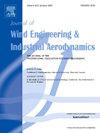Riblets and scales on 3D-printed wind turbine blades: Influence of surface micro-patterning properties on enhancing aerodynamic performance
IF 4.9
2区 工程技术
Q1 ENGINEERING, CIVIL
Journal of Wind Engineering and Industrial Aerodynamics
Pub Date : 2025-08-06
DOI:10.1016/j.jweia.2025.106188
引用次数: 0
Abstract
Surface textures that can be observed on certain natural elements, such as rice leaves, butterfly wings, shark skins, or fish scales, have inspired manufacturing of 3D-printed wind turbine blades by embedding riblets and scales to enhance the aerodynamic performance. In this study, the characteristics of the blade surface are varied by changing the 3D printing parameters (e.g., precision, layer height, and printing direction) to quantify their effects on the power and thrust coefficients of the wind turbine rotor through wind tunnel experiments. Interestingly, the change in the 3D printing parameters significantly affects the aerodynamic performance of the wind turbine rotor. Specifically, all blade models with riblets show enhanced stall performance compared to the baseline case, with greater improvements by decreasing the layer height. However, for low-precision 3D printing systems, small layer heights can result in the generation of random roughness rather than riblet or scale patterns, thus leading to significant degradation in the aerodynamic performance. The fish scale-like surfaces exhibited the highest energy efficiency with an increase of up to 78% in the power coefficient at the highest tip speed ratio tested for the rotor model.
3d打印风力涡轮机叶片上的波纹和鳞片:表面微图案特性对增强气动性能的影响
可以在某些自然元素(如水稻叶、蝴蝶翅膀、鲨鱼皮或鱼鳞)上观察到的表面纹理启发了3d打印风力涡轮机叶片的制造,通过嵌入条纹和鳞片来增强空气动力学性能。本研究通过改变3D打印参数(如精度、层高、打印方向)来改变叶片表面特性,通过风洞实验量化其对风力机转子功率和推力系数的影响。有趣的是,3D打印参数的变化会显著影响风力发电机转子的气动性能。具体来说,与基线情况相比,所有带有波纹的叶片模型的失速性能都有所提高,通过降低层高度可以获得更大的改善。然而,对于低精度的3D打印系统,较小的层高可能导致随机粗糙度的产生,而不是波纹或尺度图案,从而导致空气动力学性能的显著下降。鱼鳞状表面表现出最高的能量效率,在转子模型测试的最高叶尖速比下,功率系数增加了78%。
本文章由计算机程序翻译,如有差异,请以英文原文为准。
求助全文
约1分钟内获得全文
求助全文
来源期刊
CiteScore
8.90
自引率
22.90%
发文量
306
审稿时长
4.4 months
期刊介绍:
The objective of the journal is to provide a means for the publication and interchange of information, on an international basis, on all those aspects of wind engineering that are included in the activities of the International Association for Wind Engineering http://www.iawe.org/. These are: social and economic impact of wind effects; wind characteristics and structure, local wind environments, wind loads and structural response, diffusion, pollutant dispersion and matter transport, wind effects on building heat loss and ventilation, wind effects on transport systems, aerodynamic aspects of wind energy generation, and codification of wind effects.
Papers on these subjects describing full-scale measurements, wind-tunnel simulation studies, computational or theoretical methods are published, as well as papers dealing with the development of techniques and apparatus for wind engineering experiments.

 求助内容:
求助内容: 应助结果提醒方式:
应助结果提醒方式:


